Did you hear the one about the scientist who invented a substance that dissolves any solid object? It’s a great invention – the only trouble is he can’t find a container to put it in.
OK, so good scientist jokes are hard to come by. But, joking aside, “scientist” seems to be a bad word in the refrigeration industry. This, of course, particularly applies to climate scientists. Many in the HVACR industry tend to look less-than-fondly on the work of climate scientists — they don’t believe that climate change is happening, or, if it is, they don’t believe humans play any part in causing or contributing to it. There are compelling arguments on both sides, and that will be a topic for another day. This is more about human nature.
When scientists conduct research and give us something good — say, for example, a cure for a terrible disease, a life-saving safety feature on a new car, or a batch of remarkable compounds (refrigerants!) that will literally change the world through their ability to remove heat from a space — people take it totally in stride. But when scientists conduct research and have the nerve to tell us something we don’t want to hear — say, for example, that that delicious fettuccini alfredo is going to clog your arteries, that laying on the beach getting a “healthy” tan is actually harmful to your skin, or that over time there may be consequences for releasing large amounts of certain compounds into the atmosphere — well, people don’t want to hear it. They tend to dismiss if not angrily deny the scientists’ findings.
The refrigeration industry certainly takes its share of heat from the scientific research community, and it can be easy to feel as if we’re being ganged up on. But the good news is that we’ve got some scientists and researchers working on our side, too.
Emerson Climate Technologies is finishing work on its $35 million innovation center, “The Helix,” on the University of Dayton campus. The facility will foster an ambitious, collaborative approach to conducting research to create new technologies that address HVACR industry challenges.
When completed, the Emerson Innovation Center will focus on five HVACR industry markets: supermarket refrigeration, food service operations, residential connected homes, data center cooling, and light commercial buildings. To make this facility a real-world proving ground for solving HVACR challenges, Emerson will offer five specialized research areas under one roof.
“We see The Helix as a hub where academic researchers and industry professionals can jointly test ideas and concepts at the system level in our real-world environments,” said Ed Purvis, executive vice president, Emerson Climate Technologies.
In addition, Emerson plans for the innovation center to be a global hub of HVACR industry education. The facility includes three training rooms and the company plans to host industry meetings and hold forums for HVACR professionals on-site.
Meanwhile, Danfoss recently broke ground on a 22,000-square-foot “Engineering Tomorrow Application Development Center” in Tallahassee, Florida.
The center will include three sets of psychrometric rooms with the capability of testing air conditioning systems, including residential equipment and rooftop units from 2.5 to 50 tons and air-cooled chillers up to 150 tons.
“One of the major drivers behind this significant investment is the increasing needs of our customers to comply with the unprecedented number of U.S. Environmental Protection Agency and Department of Energy regulations and testing requirements,” said John Galyen, president, Danfoss North America. “We feel it’s critical for us to help our industry prepare for the transition ahead to meet low-global-warming-potential (GWP) refrigerant targets and higher energy-efficiency levels. There is not enough existing lab capacity in the U.S. to meet the demands, so this investment will enable our customers to accelerate the path of their next-generation equipment.”
And everyone is probably familiar with the Air-Conditioning, Heating, and Refrigeration Institute’s (AHRI’s) Low-GWP Alternative Refrigerants Evaluation Program, the industry-wide cooperative research program to identify and evaluate promising alternative refrigerants for major product categories.
The program, according to AHRI, “Is strongly desired by the industry to assess the research needs [and] accelerate industry's response to environmental challenges raised by the use of high- GWP refrigerants, and avoid duplicative work.”
These are just a few examples. Behind the scenes, every major equipment and refrigerant manufacturer recognizes the importance of research and invests in it.
I know many in the HVACR industry are at odds with our friends the climate scientists. But like many things in life, research can be a double-edged sword. Some might argue that overzealous climate research got the refrigeration industry into its current unsettled and confusing state of affairs. But if science got us into this, science can help get us out. So, let’s work together with scientists and researchers. They may not always tell us things we like to hear, but ultimately they’re pretty good people to have on our side.











